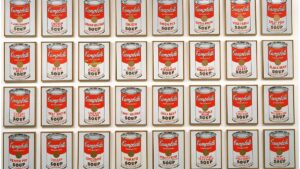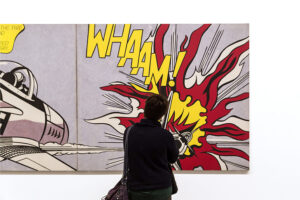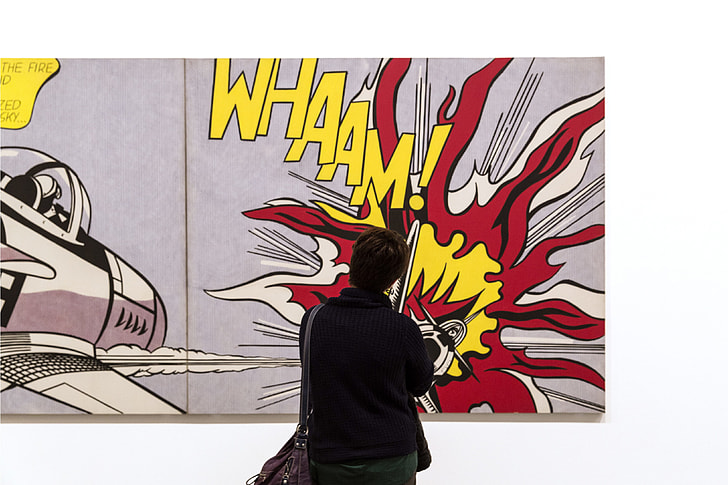Pop Art Movements: A Colorful Cultural Dive
Welcome to a world where art meets popular culture in a colorful burst. In this piece, we explore pop art movements deeply. We cover its start, key characteristics, famous names, important works, and its effect on culture. Get ready to dive into a world full of expressive art. You’ll see how pop art has shaped our culture.
 Andy Warhol – Campbel Soup Cans – Sotheby’s – About Pop Art
Andy Warhol – Campbel Soup Cans – Sotheby’s – About Pop Art
Key Takeaways:
- Pop art movements emerged as a reaction against the art world’s norms.
- This art is known for its bold colors, use of popular culture images, and a sense of humor.
- Artists like Andy Warhol and Roy Lichtenstein were key in making pop art popular.
- Works like Warhol’s Campbell’s Soup Cans and Lichtenstein’s comic-like paintings are still celebrated.
- Pop art changed advertising and fashion, and it shook up traditional art.
Defining Characteristics of Pop Art
Pop art is a movement with bright and bold styles. It has caught the eye of people all over the world. What makes pop art stand out is its unique features. These features make it a major influence in the art scene.
Bold Use of Color
Pop art is known for its vivid and brighter-than-life colors. Artists used bright colors to make their work pop. They used shades from the whole rainbow. This made their art really jump out at you.
Incorporation of Popular Culture Imagery
Pop art takes inspiration from our everyday lives and what’s popular. It uses familiar symbols and images from ads, movies, and more. By making everyday items into art, pop art changed how people saw ‘art’.
Celebration of Mass Production
Pop art celebrates the countless items produced by factories. Artists used these items in their work. This showed the world the growing importance of mass production and buying.
Irony and Satire
Pop art also jokes about society and how we view culture. Artists were witty in their work. They made us think about the funny or odd parts of daily life. This pushed people to think deeper about the media we see and what culture values.
“Pop art is about liking things.”
– Andy Warhol
Pop art changed art forever. It kept its strong colors, images from everyday life, and humor. This makes pop art still popular and loved today.
Key Figures in Pop Art
The world of pop art is filled with influential people. They shaped the movement and broke old rules. Their creativity showed the spirit of their era in lively colors and bold designs.
Andy Warhol
Andy Warhol stands out in pop art history. He mixed art with commercial ideas, making it hard to tell them apart. His works, like Campbell’s Soup Cans and Marilyn Diptych, make us think even now.
Roy Lichtenstein
 Roy Lichtenstein, Kiss V (1964)
Roy Lichtenstein, Kiss V (1964)
Roy Lichtenstein made art from comic books and ads. He used bold lines, vivid colors, and Ben-Day dots in his art. His paintings, like Whaam! and Drowning Girl, caught the eye with their look at popular culture.
Claes Oldenburg
Claes Oldenburg made huge sculptures of everyday things. His playful pieces showed ordinary items in a new light. Works like the Giant Three-Way Plug and Clothespin turned heads and made people smile.
“Pop art looks into the world of advertising, mass-produced objects, and popular culture and turns them into the very subjects of art itself.” – Andy Warhol
The work of these artists, and many more, made pop art big. They all found new ways to show the world around us. Today, their ideas still speak to people everywhere.
 Claes Oldenburg and Coosje van Bruggen, Spoonbridge and Cherry, 1988
Claes Oldenburg and Coosje van Bruggen, Spoonbridge and Cherry, 1988
Iconic Pop Art Pieces
Pop art has given us many iconic pieces that still amaze people today. They have made a big impact on the art world with their bold ideas and themes.
Andy Warhol’s “Campbell’s Soup Cans” from 1962 is a famous example. He painted 32 soup cans, each with a different label. This art challenged what people thought about art. Warhol showed that everyday things could be art. This made people think about shopping and popular culture.
Roy Lichtenstein’s art looked like comic books. His works, like “Whaam!” (1963), used bright colors and dots. They questioned what kind of art was important. His art showed that pictures from daily life were also meaningful.
Claes Oldenburg made a big plug in 1970. It was over ten feet tall. This huge plug made people smile. It made us think about what we see as important or funny in daily objects.
“Pop art looks out into the world. It doesn’t look like a painting of something, it looks like the thing itself.” – Roy Lichtenstein
 Roy Lichtenstein – Red Barn I [1969]
Roy Lichtenstein – Red Barn I [1969]
Exploring the Significance
These famous pop art pieces do more than just show art. They change how we look at art and regular life. Artists like Warhol, Lichtenstein, and Oldenburg used things from everyday life in their work.
They made art that everyone could understand and enjoy. This helped join different kinds of art together. They made people think about buying things, making things, and pictures in the world.
Next, we will look at how pop art has affected culture. It has also changed things like ads and fashion, and what we think about old art traditions.
Pop Art Movement’s Cultural Impact
Pop art has deeply affected many parts of our society. It changed advertising and fashion. This movement made culture in big ways.
Pop art is known for going against old art traditions. It used everyday things in art, making it easier to understand for more people. This made art open to everyone and inspired different kinds of art.
“Pop art is about liking things” – Andy Warhol
In ads, pop art’s use of color and style stands out. It catches people’s eyes and feels modern. Many ads use pop art’s look to seem fresh and lively.
Pop art also shaped the fashion world. Its bright colors and bold shapes are on clothes and in fashion shows. It celebrates being different and standing out.
In the end, pop art has changed a lot. It challenged old ideas about art, changed ads, and influenced fashion. Today, it still affects our world, making a mark on art, culture, and how we see things. A person looks at pop art by Roy Lichtenstein in an art gallery in London, England
A person looks at pop art by Roy Lichtenstein in an art gallery in London, England
The Cultural Impact of Pop Art: A Brief Overview
| Area of Impact | Description |
|---|---|
| Artistic Conventions | Pop art challenged traditional art forms, making art more accessible and relatable to a wider audience. |
| Advertising | Pop art’s vibrant colors, bold graphics, and popular culture references have influenced countless advertising campaigns. |
| Fashion | The bold and playful nature of pop art has made its way into clothing, accessories, and runway presentations. |
Development of Pop Art Movements
Pop art came alive in the 1950s and 1960s. It mixed different art styles with big cultural changes. This mix made art popular by using everyday items and famous faces. It still influences art today.
Origins and Early Waves of Pop Art
Back in the 1950s, artists in the UK and US first explored pop art. They loved the bright and easy-to-understand design of ads and products. They felt this should appear in art too.
The 1960s brought more fame to pop art. Artists like Andy Warhol and Roy Lichtenstein became stars. Their art, like Warhol’s soup cans and Lichtenstein’s comic-style paintings, showed off popular items and stories.
Evolution of Pop Art
During the 1960s, pop art grew and changed. New types of art and artists started doing their own pop art works. They added new styles and colors to the mix.
Drawing from everyday life gained interest in the late 1960s. Artists painted or drew scenes that looked real, almost like photos. This made people see ordinary things in a new light.
By the 1980s, pop art had mixed with other new art types. This made an even bigger range of pop art styles. Artists in this time, like Keith Haring and Banksy, added new ideas to pop art.
The Contemporary Pop Art Landscape
Today, pop art is still a big deal in the art world. Artists keep making use of popular things and themes in their work. This keeps pop art fresh and interesting for everyone.
Pop art makes us think about ads, media, and what’s popular. It also changes how we see art itself. People now see that art can come from anywhere and any time.
| Key Waves of Pop Art | Key Artists | Notable Works |
|---|---|---|
| First Wave | Andy Warhol | Campbell’s Soup Cans, Marilyn Monroe portraits |
| Roy Lichtenstein | Comic book-inspired paintings | |
| Claes Oldenburg | Monumental soft sculptures | |
| Second Wave | David Hockney | Brightly colored, unconventional perspectives |
| Photorealism | Chuck Close | Detailed, hyperrealistic paintings |
| Contemporary | Keith Haring | Iconic, bold figures and symbols |
| Banksy | Socially and politically charged street art |
David Hockney,Portrait of an Artist ( Pool with Two Figures) 1972
Pop Art’s Enduring Legacy
Looking back at the pop art movements, we see it has lasting effects. It shapes today’s art and culture in many ways. You can notice pop art in paintings, sculptures, films, and fashion.
The Evolution of Pop Art
During the 1950s and 1960s, pop art was born. It responded to a world becoming more about ads and buying. At that time, artists began using things like ads, comic books, and common objects in their art. This change brought a fresh and daring feel to art that continues to catch our attention today.
This art style loves bright colors, big pictures, and weird materials. It showed the world that art doesn’t always have to follow the old rules. Pop art made room for new ways to be creative. Artists started trying things that hadn’t been done before.
Contemporary Art and Popular Culture
Even now, pop art is a big influence on art. Modern artists learn a lot from the pop art movement. They mix its ideas with their own to make art that makes us think and feel.
Pop art also really changed how we see culture and the things around us. The fun and bold ideas from pop art show up in ads, music, fashion, and more. The unforgettable pictures from pop art are like a special language that everyone understands.
The Significance of Pop Art
“Pop art is about liking things.”
– Andy Warhol
Pop artists made everyday things into art. They brought new excitement to the art world by doing this. Their work made people talk, think, and open their minds about what art can do.
Pop art also showed that art and the everyday world can mix well. Its influence goes far beyond galleries. It keeps inspiring new ways to be creative in many different fields.
Conclusion
This article took us on an exciting journey into pop art. We explored its history from the 1950s through today. We learned about its impact on our art and culture.
Andy Warhol, Roy Lichtenstein, and Claes Oldenburg stand out in pop art history. Their famous works like Warhol’s Campbell’s Soup Cans are still celebrated today. These pieces mark a key moment in art.
Pop art has influenced more than just painting. Its bold ideas are seen in ads, clothes, and our daily lives. By turning everyday things into art, pop art changed the game for artists.
Looking back, our dive into pop art was truly eye-opening. Its story shows us how art can break boundaries and stay relevant. The pop art movements have left a big mark, still guiding artists today.
FAQ
What are pop art movements?
Pop art movements started in the mid-20th century. They used popular culture in their art. This made art more about everyday life and less about rare, one-of-a-kind pieces. It was a big change.
What is the history of pop art?
Pop art began in the 1950s and 1960s. It started in the UK and the US. Artists like Andy Warhol and Roy Lichtenstein made it famous. Pop art is still a big part of art and pop culture today.
What are the defining characteristics of pop art?
Pop art is known for bright colors and simple shapes. It uses things from everyday life and popular culture. It often shows humor and brings some fun to the art world.
Who are the key figures in pop art?
Andy Warhol and Roy Lichtenstein are big names in pop art. Jasper Johns and Robert Rauschenberg are important too. They all had a large role in making pop art what it is.
What are some iconic pop art pieces?
Classic pop art includes Andy Warhol’s “Campbell’s Soup Cans.” “Whaam!” by Roy Lichtenstein and Jasper Johns’ “Flag” are also famous. Claes Oldenburg’s “Giant Three-Way Plug” is another well-known piece.
What impact has pop art had on culture?
Pop art changed how we see art and the world around us. It influenced advertising, fashion, and design. By using everyday things, it showed us that art is everywhere.
How did pop art movements develop?
Pop art came about as a reaction to other art styles. Artists wanted to make art that everyone could enjoy. They turned to everyday items for inspiration.
What is the enduring legacy of pop art?
Pop art is still very important today. Many artists use its ideas in their work. Its influence can be seen in how we design and think about art and culture.


 Red Disaster by Andy Warhol
Red Disaster by Andy Warhol Pop Art Museum | San Angelo
Pop Art Museum | San Angelo